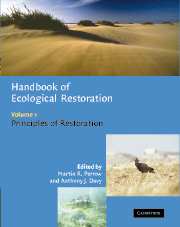Book contents
- Frontmatter
- Contents
- List of contributors
- Foreword
- Preface
- Part 1 The background
- Part 2 Manipulation of the physical environment
- Part 3 Manipulation of the chemical environment
- Part 4 Manipulation of the biota
- 12 Establishment and manipulation of plant populations and communities in terrestrial systems
- 13 Ecology and management of plants in aquatic ecosystems
- 14 Micro-organisms
- 15 Terrestrial invertebrates
- 16 Aquatic invertebrates
- 17 Fish
- 18 Reptiles and amphibians
- 19 Birds
- 20 Mammals
- Part 5 Monitoring and appraisal
- Index
- References
14 - Micro-organisms
Published online by Cambridge University Press: 29 December 2009
- Frontmatter
- Contents
- List of contributors
- Foreword
- Preface
- Part 1 The background
- Part 2 Manipulation of the physical environment
- Part 3 Manipulation of the chemical environment
- Part 4 Manipulation of the biota
- 12 Establishment and manipulation of plant populations and communities in terrestrial systems
- 13 Ecology and management of plants in aquatic ecosystems
- 14 Micro-organisms
- 15 Terrestrial invertebrates
- 16 Aquatic invertebrates
- 17 Fish
- 18 Reptiles and amphibians
- 19 Birds
- 20 Mammals
- Part 5 Monitoring and appraisal
- Index
- References
Summary
INTRODUCTION
Most restoration ecologists have concerned themselves with the re-establishment of desirable plants and animals but generally overlook the resource base upon which the animal and plant communities are maintained, the soils. Reconstructing the soils is difficult because a soil comprises both organic and inorganic components that have weathered in situ for a very long time. As such, despite the best efforts, soils that have been reconstructed always contain early-successional characteristics (see Marrs, this volume). In most situations, the plants that colonise early-successional sites and are capable of surviving on these soils are not those that are considered desirable for restoration ‘success’. Restoration managers are primarily responsible for placing late seral vegetation into early seral soils.
Existing at the interface of plant and soil are soil organisms: the most diverse group of organisms at any site. Current estimates using molecular diversity measurements suggest that there are from 4000 to 40,000 distinct genetic populations of soil organisms per gram of soil, of which only less than 5% potentially may be cultured (e.g. Collins et al., 1995; Allen et al., in press)! No accurate estimates of soil organism richness across a landscape exist but it certainly is in the thousands to millions. These organisms change with successional time (many form highly specific associations with a limited number of plant species) in addition to their activities being altered due to discontinuous resource inputs (in the form of organic matter) and soil structural and compositional changes.
- Type
- Chapter
- Information
- Handbook of Ecological Restoration , pp. 257 - 278Publisher: Cambridge University PressPrint publication year: 2002
References
- 4
- Cited by

